Granite is a crystalline igneous rock that consists largely of feldspar and quartz. These two are the most common minerals in the crust which means that granite too is among the most ubiquitous rock types, especially in the upper continental crust.

This picture of a granite pegmatite from northern Norway (Nyelv) is very coarse-grained for a normal granite and compositionally simpler than most granite samples, but it illustrates well what granite is. It is crystalline (composed of visible mineral grains) and always contains quartz which usually is gray and also feldspar which is either reddish, white or yellow in most cases. Few dark spots are mineral biotite. Width of view is about 50 cm.
Although it is indeed very widespread, not every rock that is named so is a true granite. This rock name may well be the most abused geological term in existence. This article aims to explain what really is granite and what it is not.
Classification
Granite is a coarse-grained quartzo-feldspathic igneous rock which contains 20-60% quartz of total quartz + feldspar (other minerals are neglected) and 35-90% of the feldspar is alkali feldspar (orthoclase or microcline). Rocks which fulfil the quartz content requirement but have a different ratio of feldspars have different names although they are known as granitoids or granitic rocks too. Granitic rocks which contain less than 10% plagioclase feldspar are named alkali feldspar granite and granitic rocks where the dominant feldspar is clearly plagioclase (over 65%) are named either granodiorite (65-90% of feldspar is plagioclase) or tonalite (over 90% of feldspar is plagioclase)2. See the diagram below:

Classification of granite (red field) and granitic rocks (red+yellow) is based on the content of quartz (Q) (in relation to feldspar) and the mineralogy of the feldspar group minerals (A and P).
These rocks are known as granitoids (rocks resembling granite) because it may not be easy to distinguish different feldspar group minerals in the hand sample. But it should remain just a field term. It makes sense to classify granitic rocks based on the feldspars because rocks from different tectonic regimes tend to have different feldspar content. True granites, for example, are virtually absent in the oceanic crust although there are granitic rocks which are rich in plagioclase (tonalite).
Similarly coarse-grained igneous rocks that contain less quartz are named syenite (feldspar is mostly alkali feldspar), monzonite (contains both feldspars in roughly equal amounts) and diorite (plagioclase-rich). Rocks that contain more than 60% quartz as an average of voluminous igneous intrusion are uncommon because silicic magma from which granite crystallizes almost always contains enough potassium, sodium and calcium to form lots of feldspars in addition to pure silica (quartz). Feldspars actually precede quartz in the crystallization order from magma. So quartz can form only if there is free silica left after other cations have already satisfied their need for silica. In the vast majority of cases it contains more feldspar than quartz.
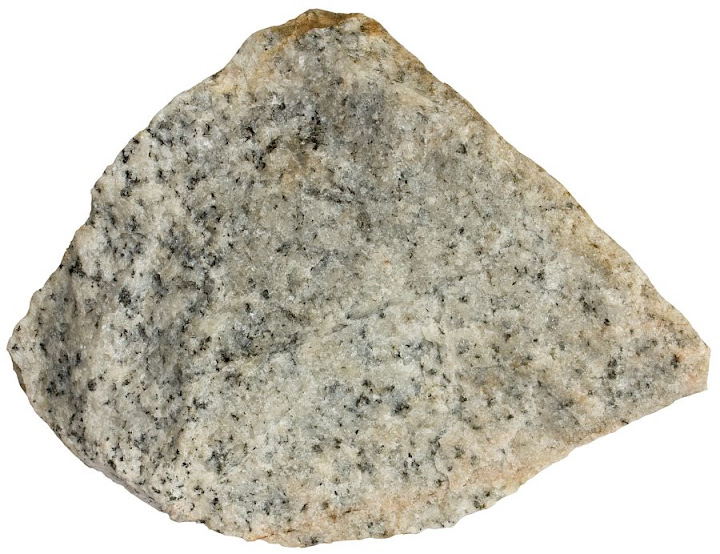
Trondhjemite is a leucocratic variety of tonalite. It is a granitic rock, but not true granite because the feldspar it contains is sodic plagioclase, not alkali feldspar. Width of sample from Norway is 10 cm.
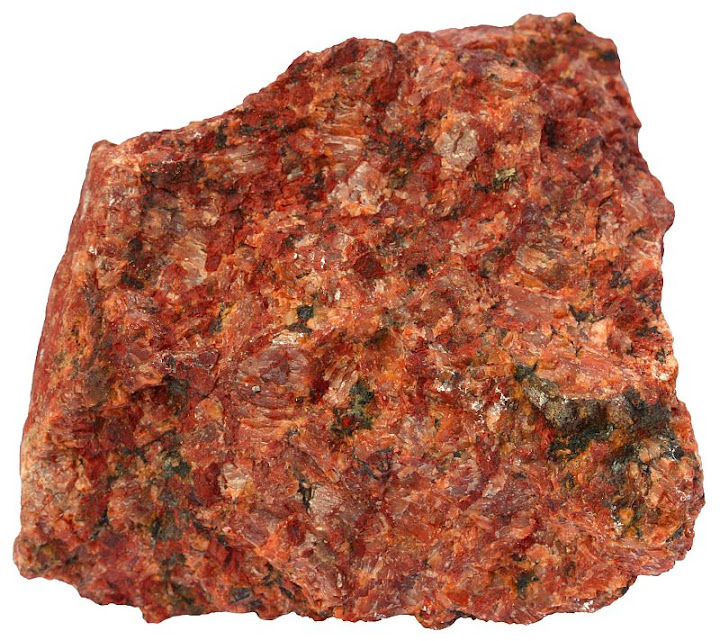
Syenite may be similar to granite, but it does not contain enough quartz. This sample is quartz alkali feldspar syenite from Estonia. Width of sample 8 cm.
Texture
Granite is a coarse-grained igneous rock with average grain size ranging from 1 to 25 millimeters1. These rocks crystallize from a very slowly cooling magma within the crust where they are well insulated. Time gives crystals a chance to grow. Volcanic rocks with a similar composition exist as well. These are known as rhyolite (volcanic equivalent of granite) and dacite (similar in composition to plagioclase-rich granitoids). The groundmass of these rocks is very fine-grained although they frequently contain phenocrysts (larger crystals that were already formed before the extrusion to the surface) embedded in the finer matrix. Granite that crystallized in a narrow dike may be fine-grained because the heat was rapidly lost to the adjacent rocks. Such granite is known as aplite. Sometimes granite is very coarse-grained. That too happens usually close to the margins of a granitic pluton, but the coarseness is mostly a result of volatiles in the magma which greatly reduce its viscosity and therefore enhance crystal growth. These coarse-grained granites are known as pegmatites.
It has often roughly uniformly sized crystals which show no preferred orientation but that is not always the case. Some granites just like rhyolites contain phenocrysts – crystals that are clearly bigger than the material surrounding it. These phenocrysts are usually feldspar crystals. The difference between granite and rhyolite is that in granite even the finer material is visibly crystalline, but in rhyolite the individual crystals within the groundmass are not visible to the naked eye. Elongated minerals may have a preferred orientation. Sometimes so much that it is no longer clear whether it is a granite or gneiss. Some granites have special textures like rims of one mineral around the other. Rapakivi granite is a notable example.

Typical granite has visible mineral grains without any orientation. Orange mineral is alkali feldspar, gray is quartz. Picture taken in Norway. Width of view 20 cm.

It may have a preferred orientation. Note how most of the biotite flakes are aligned sub-parallel to each-other. Lødingen, Hinnøya, Norway. Width of sample 15 cm.

Aplite in the lower half is much finer than granite above it. Their composition seems to be the same. There are larger phenocrysts of quartz and feldspar within the granite. Width of sample 12 cm.

Gneiss and granite may be the same compositionally, but elongated mineral grains are strongly oriented and segregated in gneiss. The sample of gneiss is from Karelia, Russia. Width of sample 11 cm.
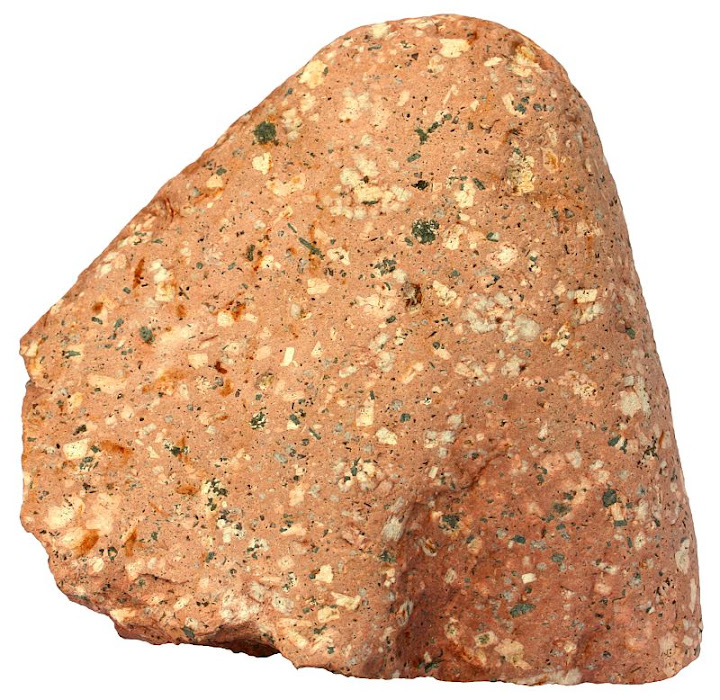
Rhyolite and dacite are extrusive versions of granitic rocks. Their groundmass is very fine-grained, but they often contain phenocrysts, mostly feldspars. The sample from Scotland is 8 cm in width.
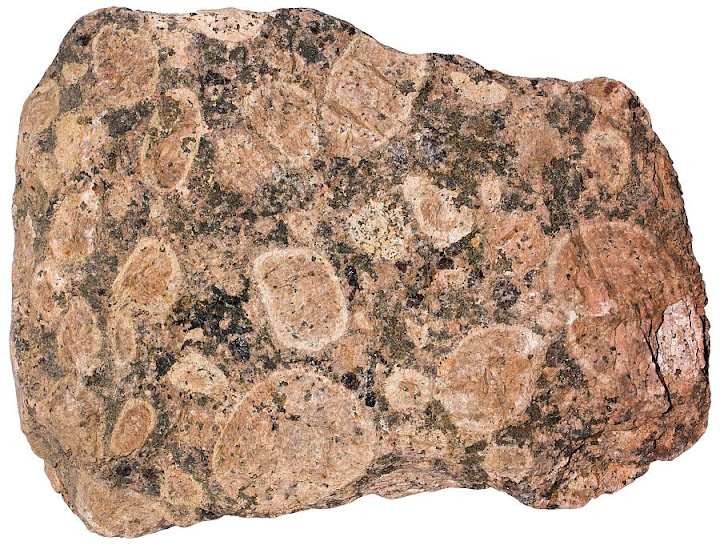
Rapakivi texture (plagioclase rims around ovoidal phenocrysts of alkali feldspar) in granite. Luumäki, Finland. Width of sample 17 cm.

Graphic texture (quartz intergrowth in feldspar that resembles runic script) is common in pegmatites. Quartz crystals are uniformly scattered in the feldspar crystals and not randomly oriented. These crystals grew simultaneously with alkali feldspar host and they are optically continuous (one crystal). The term “pegmatite” was originally used to describe graphic granites by Haüy in 1822. Graphic granites may indeed be described as pegmatites even according to current usage, but the term “pegmatite” nowadays has much wider meaning, encompassing also rocks which have no graphic texture nor do they have to be granitic in composition4. Evje, Norway. Width of sample 9 cm.
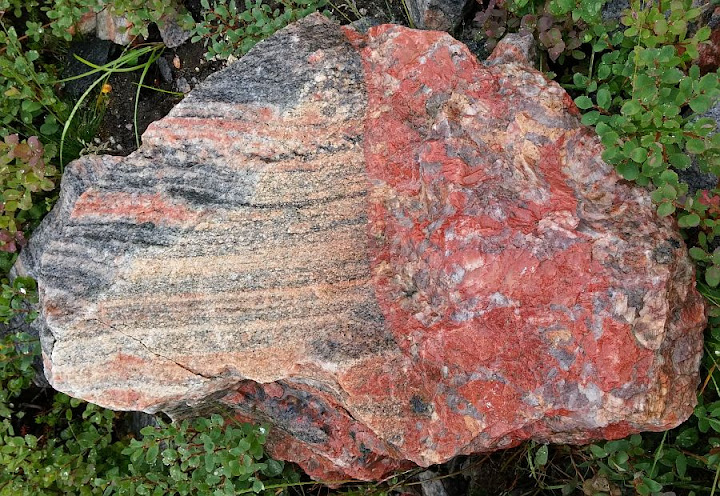
A contact between gneiss (granodioritic with migmatitic granite veins) and granite pegmatite. Nyelv, Norway.
Composition
Average chemical composition of granite determined by 2485 chemical analyses of granitic rocks3 (numbers are mass percents, recalculated volatile-free to total 100%):
SiO2 — 71.84
TiO2 — 0.31
Al2O3 — 14.43
Fe2O3 — 1.22
FeO — 1.65
MnO — 0.05
MgO — 0.72
CaO — 1.85
Na2O — 3.71
K2O — 4.10
P2O5 — 0.12
Notable is a very high SiO2 which is the reason why it contains so much quartz. The amount of iron, magnesium and titanium are low when compared with basaltic rocks.
Minerals quartz and feldspar take most of the silicon, oxygen, potassium, sodium, aluminum, and calcium. Small amounts of other chemical elements will find their place in the crystal lattice of apatite (accommodates phosphorus), magnetite and ilmenite (iron and titanium), biotite and hornblende (iron, magnesium), muscovite (potassium, aluminum, fluorine), zircon (zirconium), titanite (titanium), monazite (rare earth elements, phosphorous). Some granites or granite-like rocks may contain pyroxene or even olivine which are rich in iron and magnesium.
Dark minerals are usually either biotite (mica) or hornblende (amphibole group mineral). It is usually biotite in potassium-rich true granites and more often hornblende in granodiorites and tonalites.
Pegmatites may be either simple (ordinary granite with large crystals) or complex. In the latter case granite has an elevated concentration of rare chemical elements which give rise to rocks with unusual composition. Minerals that often occur in granite pegmatites are tourmaline (contains boron), topaz (fluorine), spodumene (lithium), cassiterite (tin), fluorite (fluorine), lepidolite (lithium), zircon (zirconium). Complex pegmatites may be very valuable as mineral resources. Simple pegmatites may be mined as well, mostly because of large muscovite flakes they often contain.
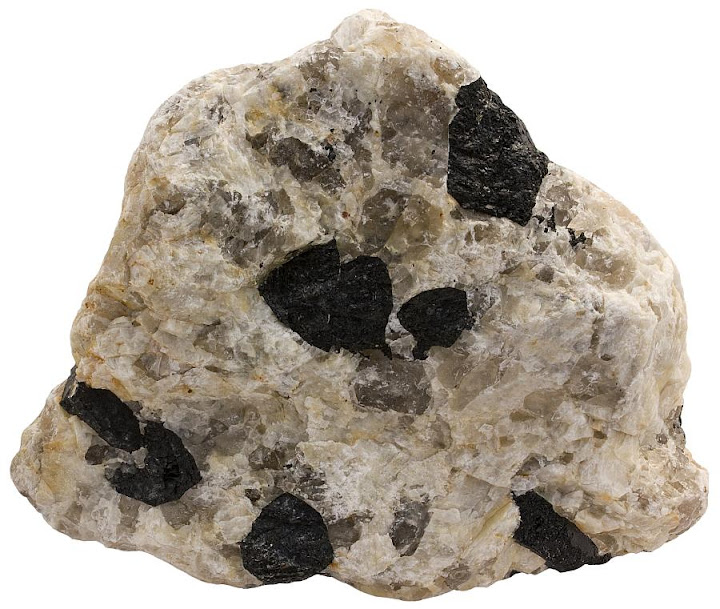
Granite pegmatite with tourmaline (schörl). Kaatiala, Finland. Width of sample 11 cm.

Lepidolite (lithium mica) with cleavelandite (variety of albite) in a pegmatite. Haapaluoma, Finland. Width of sample 12 cm.
Types
Several classification have been propesed for granitic rocks. The most common way is to divide them into (I,S,M,A) types. Most of these letters refer to protoliths. I-type granite is the most common one which is believed to have an igneous protolith. S-type granites originate at least partly from a sedimentary source. M-type granites are rare and are supposed to have mafic protolith although this is somewhat problematic because mafic rocks do not yield granitic melt. ‘A’ means anorogenic. These are granites from plutons that were not associated with magmatism related to subduction processes and mountain-building. This classification scheme, although still widely in use, is somewhat problematic and inconsistent.
Newer and perhaps better or at least more easily quantifiable method is to use alumina saturation index. In this scheme the molecular ratio of Al2O3/K2O + Na2O + CaO is calculated. This ratio is useful because it is 1 in feldspars. So the excess or deficiency of aluminum must be accommodated by other minerals.
If granite is rich in aluminum, it contains muscovite in addition to feldspars plus other aluminum-bearing accessory minerals like corundum, tourmaline, cordierite, etc. These rocks are known as peraluminous granites.
Rocks which have Al2O3/K2O + Na2O + CaO below 1 but Al2O3/K2O + Na2O over 1 are metaluminous. These rocks are alumina deficient which means that minerals like biotite (Al-poor) and hornblende must crystallize in addition to feldspars.
Third category of granites (known as peralkaline) are even more deficient in alumina: Al2O3/K2O + Na2O < 1. These rocks contain alkali pyroxenes and amphiboles (aegirine, riebeckite) and even iron-rich olivine fayalite.
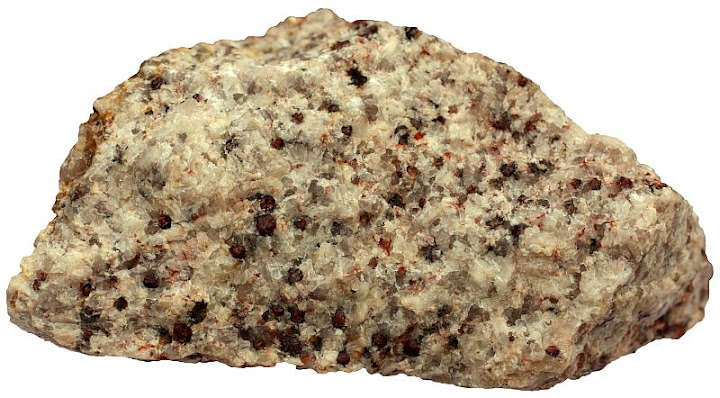
Peraluminous granite with garnet phenocrysts. Granites that contain lots of aluminum may have a sedimentary protolith (S-type granites). Aluminum comes from pelitic (rich in clay minerals) sedimentary rocks. Width of sample from Estonia is 8 cm.

Peraluminous granite from Estonia. The excess of aluminum is accommodated in light-colored mica muscovite. Width of sample 10 cm.
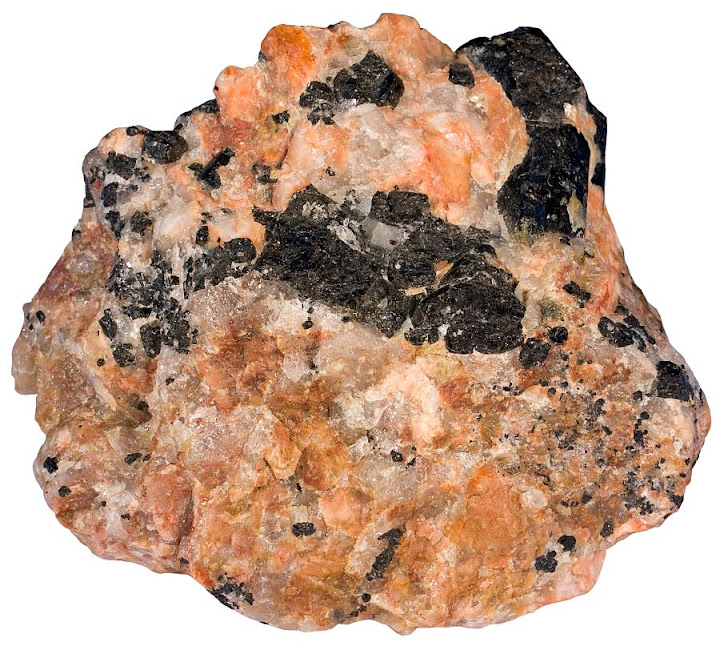
Metaluminous granite containing lots of hornblende (black). Width of sample 9 cm.

Peralkaline granite pegmatite. Black mineral is amphibole riebeckite. Width of sample 7 cm.
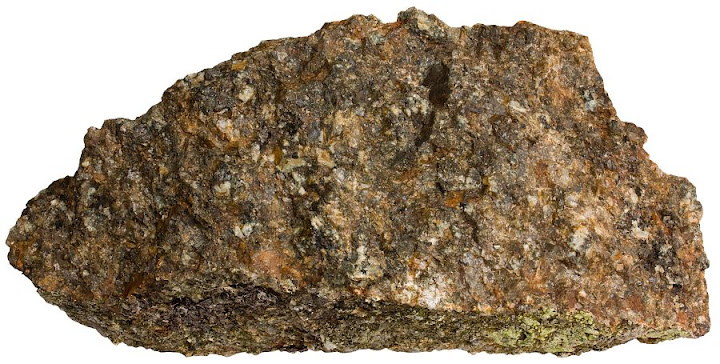
Peralkaline granite with iron-rich end-member of olivine group: fayalite. Southern Norway. Width of sample 18 cm.

Charnockite is an enigmatic rock which compositionally could be a subtype of orthopyroxene-bearing granite, but it probably formed as a result of metamorphic processes deep in the crust. It is perhaps better to classify such rocks as granulites. Flakstadøya, Lofoten Islands, Norway. Width of sample 9 cm.
Occurrence
Granite is one of the main ingredients of the continental crust. Although continental landmasses are composed of many different igneous, sedimentary and metamorphic rocks, originally they were derived from the mantle by a process called partial melting which will step-by-step lead to the generation of granitic magma. When rocks melt the liquid that forms has different composition than the original source rock. When peridotite melts, basaltic rocks form which contain more silicon and aluminum and less iron and magnesium. Basalt is because of its chemical composition more light-weight and moves upward and solidifies as a lava on the surface or as dikes in the crust. When basalt melts even lighter magma forms which will lead to the formation of granite. It is therefore a result of a remelting of the material from the continental crust.
Granite is so light-weight when compared to the original peridotite that it can not subduct back to the mantle. So it remains buoyant as a young continent. These continents will go through multitude of processes. Continents collide and metamorphose, they are worn down by weathering and igneous processes add new material. It has taken very long time. The process started probably right after the formation of the Earth as a planetary body. The cores of continents formed in the Archaean and they tend to grow bigger because the continental crust that has already formed can not sink to the mantle again. As a result continents are structurally complex mixtures of virtually every rock type known to us. Granite being perhaps the most important of them.
Not all of these rocks are granites in the strict petrological sense. Major part of this material is clearly metamorphosed and should be described as gneiss. However, our knowledge about the interior of the crust mostly comes from the seismic studies and for the seismic waves it does not make any difference whether it is granite or a granitic gneiss. This is why it is often assumed that the continental crust is granitic. Furthermore, the composition of this material is not necessarily granitic in the strict sense. Plagioclase feldspar is more common in the crust than alkali feldspar. So it is fair to assume that the dominant rock type in the continental crust is a metamorphic rock with a granodioritic composition.
True granites occur mostly in plutons which are pancake-shaped igneous intrusions in the upper crust. Sometimes they reach the surface when the material above them has been removed by the weathering processes. These plutons vary enormously in size (1-1,000,000 km3)1. The mechanism how they formed has been very controversial. The dominant hypothesis has been that they are the result of igneous diapirism – igneous material rises through the crust like a hot balloon. The formation of some granite plutons may be partly explained that way, but it seems more likely that the migration of granitic melt took place in the network of narrower cracks in the rocks. It seems rather difficult to understand how can very large balloon of hot magma move through the cold and rigid rocks of the upper crust. The formation process of granitic melt is known as migmatization and the rocks that contain metamorphic rocks mixed with magmatic veins are known as migmatites.

Much of the ‘granitic’ continental crust is actually made of granodioritic gneisses like the example above. Karelia, Russia (Archaean Fennoscandian Shield). Width of sample 16 cm.

Migmatite erratic on the northern coast of Estonia. Migmatites are mixtures of metamorphic and igneous rocks. Igneous material usually has a granitic composition and is either a result of partial melting in situ or is a magma that formed elsewhere and intruded into the rocks where we see it now. Migmatization seems to be the mechanism how granitic magma is formed and how it migrates in the crust.

Outcrop of a granite intrusion north of the High-Atlas mountain range in Morocco.
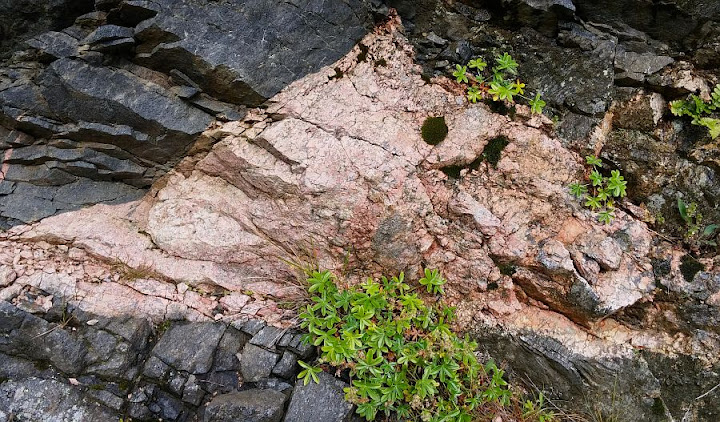
Granite cutting through calc-silicate schist. Gimsøy, Lofoten Archipelago, Norway.

Large granite dike (several meters wide). Å, Lofoten Archipelago, Norway.
Uses
Granite has several uses. It may contain valuable minerals. These may be either gemstones or industrial minerals. Pegmatites are especially rich source of both beautiful and rare crystals and minerals with useful properties. Zircon, beryl and tourmaline crystals come from pegmatites. Also industrial minerals like micas and feldspars are taken from pegmatites because large grain size makes the separation process easier. Zirconium and beryllium are extracted from granite pegmatites (minerals zircon and beryl, respectively). Granite may contain ore minerals. Tin and tungsten ores, for example, are hosted by granite.
Granite is an important construction material. It is hard and durable which makes it a very good material for aggregate. It is one of the most important dimension stones because of beautiful textures and colors. It is also massive and durable – ideal material for countertops. It must be said, however, that not all of these granites are true granites. Some of them are metamorphic although are granitic in composition. But sometimes rocks with much lower quartz content are named granite. For a geologists they may be diorite, monzonite, syenite, diabase, gabbro, etc. These rocks are also known as commercial granite.

Rapakivi granite is a variety of granite widely used as a dimension stone. Luumäki, Wyborg batholith, Finland. Width of view 35 cm.
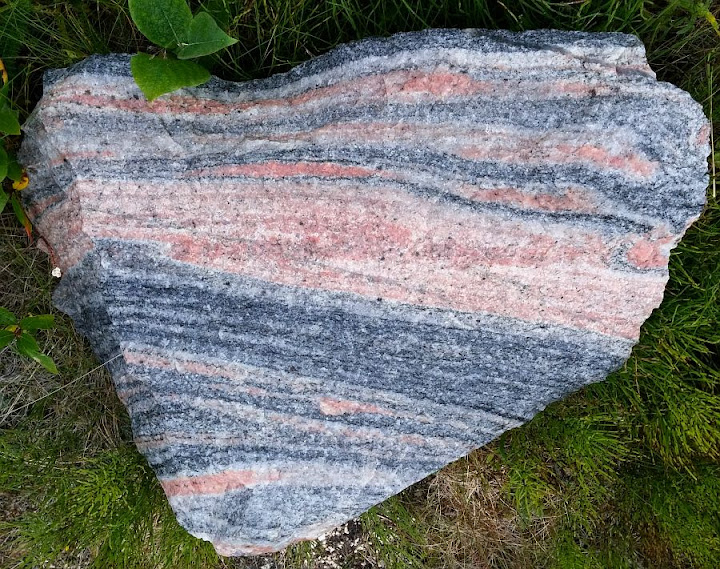
This ‘granite’ from Norway (Nyelv) is actually migmatitic gneiss, but such rocks are usually marketed as granite (commercial granite).
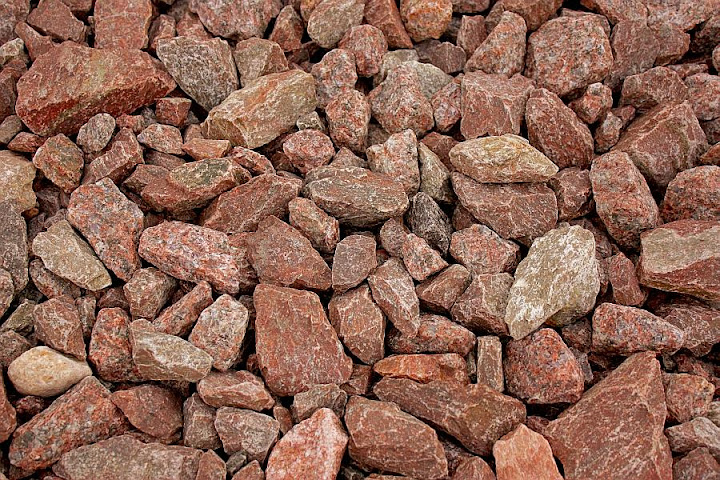
Granite is an excellent material when hard and durable rocks are needed. These granitic rocks are used as a railroad ballast in Estonia.
References
1. Barker, Fred. (2007). Granite. In: McGraw Hill Encyclopedia of Science & Technology, 10th Edition. McGraw-Hill. Volume 8. 202-204.
2. Le Maitre, R. W. (2005). Igneous Rocks: A Classification and Glossary of Terms: Recommendations of the International Union of Geological Sciences Subcommission on the Systematics of Igneous Rocks, 2nd Edition. Cambridge University Press.
3. Best, Myron G. (2002). Igneous and Metamorphic Petrology, 2nd Edition. Wiley-Blackwell.
4. Jackson, J. A. (1997). Glossary of Geology, 4th Edition. American Geological Institute.
Thanks for the post!